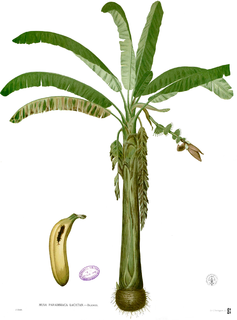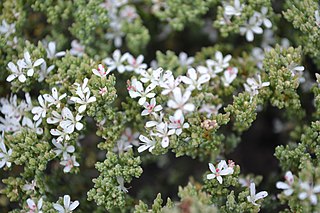
Senecio is a genus of flowering plants in the daisy family (Asteraceae) that includes ragworts and groundsels.

Musaceae is a family of flowering plants composed of three genera with about 91 known species, placed in the order Zingiberales. The family is native to the tropics of Africa and Asia. The plants have a large herbaceous growth habit with leaves with overlapping basal sheaths that form a pseudostem making some members appear to be woody trees. In most treatments, the family has three genera, Musella, Musa and Ensete. Cultivated bananas are commercially important members of the family, and many others are grown as ornamental plants.

The Marantaceae are a family, the arrowroot family, of flowering plants consisting of 31 genera and around 530 species, defining it as one of the most species-rich families in its order. Species of this family are found in lowland tropical forests of Africa, Asia, and the Americas. The majority (80%) of the species are found in the American tropics, followed by Asian (11%) and African (9%) tropics. They are commonly called the prayer-plant family and are also known for their unique secondary pollination presentation.

The Combretaceae, often called the white mangrove family, are a family of flowering plants in the order Myrtales. The family includes about 530 species of trees, shrubs, and lianas in ca 10 genera. The family includes the leadwood tree, Combretum imberbe. Three genera, Conocarpus, Laguncularia, and Lumnitzera, grow in mangrove habitats (mangals). The Combretaceae are widespread in the subtropics and tropics. Some members of this family produce useful construction timber, such as idigbo from Terminalia ivorensis. The commonly cultivated Quisqualis indica is now placed in the genus Combretum.

Malpighiaceae is a family of flowering plants in the order Malpighiales. It comprises about 73 genera and 1315 species, all of which are native to the tropics and subtropics. About 80% of the genera and 90% of the species occur in the New World and the rest in the Old World.

Ruppia, also known as the widgeonweeds, ditch grasses or widgeon grass, is the only extant genus in the family Ruppiaceae, with eight known species. These are aquatic plants widespread over much of the world. The genus name honours Heinrich Bernhard Rupp, a German botanist (1688-1719). They are widespread outside of frigid zones and the tropics.

Arnoglossum is a North American genus of plants in the sunflower family, described as a genus in 1817. They have the Common name Indian plantain because they resemble the unrelated common plantain.

Olacaceae is a family of flowering plants in the order Santalales. They are woody plants, native throughout the tropical regions of the world. As of July 2021, the circumscription of the family varies; some sources maintain a broad family, others split it into seven segregate families.
Triunia is a genus of medium to tall shrubs or small trees found as understorey plants in rainforests of eastern Australia. Members of the plant family Proteaceae, they are notable for their poisonous fleshy fruits or drupes. Only one species, T. youngiana, is commonly seen in cultivation.

Astereae is a tribe of plants in the family Asteraceae that includes annuals, biennials, perennials, subshrubs, shrubs, and trees. Plants within the tribe are present nearly worldwide divided into 170 genera and more than 2,800 species, making it the second-largest tribe in the family behind Senecioneae. They are found primarily in temperate regions of the world.

Thymophylla is a genus of perennial flowering plants in the marigold tribe within the sunflower family. Pricklyleaf is a common name for plants in this genus.

Cylindrocline is a genus of flowering plant in the sunflower family.
Egletes is a genus of flowering plant in the family Asteraceae. It is native to South America, Mesoamerica, and the West Indies, with the range of one species barely crossing the US border into the extreme southern part of Texas.

Uvaria is a genus of flowering plants in the family Annonaceae. The generic name uvaria is derived from the Latin uva meaning grape, likely because the edible fruit of some species in the genus resemble grapes.
Gibbaria is a genus of plants in the sunflower family, endemic to South Africa. The only known species is Gibbaria scabra.
Isocarpha (pearlhead) is a genus of flowering plants in the sunflower family. They are native to Mexico, Central America, the West Indies, and northern South America, with the range of one species extending north into the United States.

Rayjacksonia is a genus of North American flowering plants in the daisy family, Asteraceae. It is one of several genera with the common name tansyaster.
Florestina is a genus of flowering plants in the sunflower family, native to Texas, Mexico, and Central America.

Frankenia is the only genus in the Frankeniaceae family of flowering plants. Other genera have been recognized within the family, such as Anthobryum, Hypericopsis and Niederleinia, but molecular phylogenetic studies have consistently shown that they all belong inside Frankenia. Frankenia comprises about 70–80 species of shrubs, subshrubs and herbaceous plants, adapted to saline and dry environments throughout temperate and subtropical regions. A few species are in cultivation as ornamental plants.
Chevreulia is a genus of plants in the sunflower family, described as a genus in 1817.














